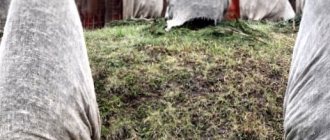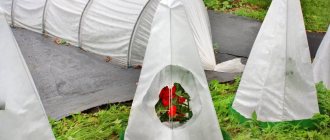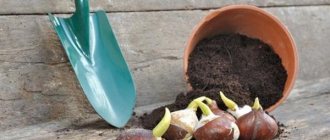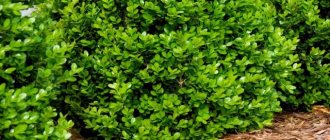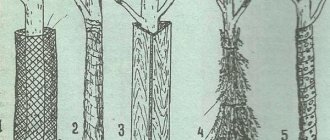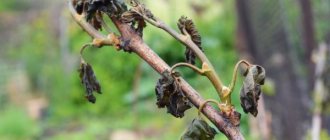Rose and winter hardiness
The winter hardiness of roses depends on the species. Some varieties in the middle zone do not need to be covered for the winter. In the Moscow region and other regions of the Central zone, modern hybrid forms of the Rugosa rose overwinter without problems.
Canadian park roses are distinguished by high frost resistance:
- Adelaide Hoodless;
- Prairie Joy;
- Winnipeg Parks;
- Hope of Humanity.
Climbing roses are popular among gardeners. Some varieties tolerate frosts down to -30 °C (Alchemist, Hendel), others freeze out when the thermometer drops to -7 °C. Climbing roses of continuous flowering require good shelter for the winter:
- Lagoon;
- Parade;
- Paul Scarlett.
Most hybrid tea varieties cannot withstand frosty winters; they are easier to grow in the southern regions. They require mandatory shelter if the temperature drops to -20 °C in winter. Floribunda roses are frost-resistant, but in Siberia and the Urals they are covered for the winter.
When purchasing a seedling, you must check the frost hardiness zone (USDA). There are 13 of them and each has its own minimum temperature value. It is given without taking into account shelter. If there is a covering layer, roses can withstand frosts 5-10 ° lower than indicated in the recommendation.
How to cover coniferous plants?
Many of them also require insulation. Some conifers can do without shelter, but thujas, especially young ones, are better insulated for the winter.
First, from the middle to the end of October, you need to carry out dry fertilizing. Complex mineral fertilizer is poured around the tree trunk circle. Lay mulch on top in a layer of 10–20 cm. It is better to use peat. If winter promises to be harsh, then spruce branches are placed on top of the mulch. In the spring you will need to remove the branches, and the fallen needles and mulch will become an excellent spring feeding.
Covering the thuja for the winter should protect it from:
- heavy snow cover;
- negative temperatures;
- bright sun at the end of winter, at the beginning of spring.
If the seedlings are young and still small, then they can be covered with plastic bottles with the necks cut off.
If you bought a very small thuja in late autumn, then it is better to leave it in the same pot for the winter. You can put it on a glazed balcony, where the temperature in winter is below +5°C. Sometimes add snow under the plants, which will also serve as watering.
Here are the materials suitable for covering thuja for the winter.
- Gauze.
This material is cut into strips 50 cm wide, which are fastened together with a stapler. The insulation is fixed at the top of the thuja and at the bottom.
Kraft paper.
First, the tree branches are pressed against the trunk and wrapped well in wrapping paper. The strips need to be laid overlapping, overlapping the previous one by 10 cm. First, you need to wrap the top of the thuja, then gradually lower down, twisting the plant in a spiral. To prevent craft paper from unrolling, it is secured with wire, a stapler, or twine.
You can use it to sew insulation that will last 5–7 seasons or simply tie it around plants.
Young thujas are insulated using a frame. To make it yourself, prepare:
- thick slats;
- reliable wire;
- bars;
- metal corners;
- plastic pipes.
If the thuja does not have a very fluffy and voluminous crown, then you can use three supports.
It is best to make a triangular frame, one that will not collapse under the weight of snow. Stick slats or bars, pipes, slats around the thuja to a depth of 40 cm. Secure the upper ends above the top of the tree with wire. Horizontal crossbars are attached to the vertical ones.
A bag-cover is put on top of this base, to which you need to sew ribbons and tie them around the frame.
To make the wrapped trees look attractive, you can draw whatever you want on the paper coverings, for example, funny faces. Play with dark-colored material, using dry sticks to create a small architectural form similar to a wigwam.
In early spring, do not rush to remove the shelter. It will protect the branches from burning out due to the bright sun. For the winter, it is necessary to insulate not only the branches of the thuja, but also the circle around the trunk.
To decide which material to use for this, check out the ones presented. They can also be used to mulch the soil under other heat-loving crops, adding a touch of originality when insulating them.
Choosing a covering material
In winter, bushes suffer not only from low temperatures. Many inexperienced gardeners end up with damping off due to improper shelter. In the middle zone, temperature fluctuations are not uncommon. Infection of plants occurs when natural materials are used. When deciding how to cover your roses for the winter, consider:
- frost resistance of the variety;
- weather conditions of the area;
- properties of the material (purchased, natural).
CHARACTERISTICS
|
Purchased
Industrially produced covering materials for roses for the winter have different composition, price, and quality. Agrotextiles are sold in rolls or pieces of a certain format. Covering properties are determined by density; it is measured in g/m². The higher the value, the more reliable the protection.
Lutrasil
Lightweight durable material for long lasting use. Can be used for several seasons. Advantages of lutrasil:
- allows air to pass through;
- there is no greenhouse effect underneath;
- the canvas does not get wet.
To protect the flower garden from frost, white lutrasil with a density of 60 g/m² is best suited. Roses are covered with material folded in 2 layers.
Important!
The larger the shelter area, the better the plants tolerate frost.
To cover the bushes, you can use less dense material (30-50 g/m²). It is rolled into 3-4 layers. A linear meter of lutrasil costs from 25 to 50 rubles. For erect, thick shoots, they sew covers with their own hands from covering material. Flexible varieties of roses are bent to the ground, leaving a gap to the ground (10-20 cm), arches are placed, and a non-woven fabric is thrown over it. It is fixed on the sides with studs, bricks, and boards.
Geotextiles
Geotextiles have long been used in industrial rose gardens in the Moscow region. The fabric is sewn together from 3 layers, covering large areas. All varieties of roses winter well under it without hilling. Group plantings are covered in one piece. Covers are sewn for standard and climbing types of roses.
The canvas is laid on arches or supports, this allows you to distribute the snow load. Leaves are removed from the bushes and bent down. The soil is covered with mulch from a mixture of dry sawdust and horse manure.
Geotextiles are used in construction and landscape design. It consists of polymer fibers. They sell it in rolls of different widths. You can purchase ready-made geotextile covers in gardening stores. Advantages of the material:
- strength;
- durability;
- frost resistance;
- environmental friendliness;
- air and water permeability;
- no condensation.
Advice!
To cover rose gardens, it is better to use needle-punched geotextiles with a density of 200 g/m².
Polyethylene film
The attitude towards film as a means of protection against frost among flower growers is not clear. There are negative reviews, but many people use it successfully. In regions with harsh winters and thick snow cover, roses winter well under the cover of plastic film. The air cushion underneath protects the roots and shoots of roses from freezing.
Spunbond
This material can be used for several seasons. It allows water and air to pass through. The cost of spunbond is not high, which makes it affordable. It is used for wrapping single standard-type bushes, stretched onto frames made of plastic (metal) arcs, bars, and willow rods.
Spunbond is used in 2-3 layers, only white in density:
- 30 g/m²;
- 40 g/m²;
- 60 g/m².
Sackcloth
Jute or polypropylene sugar bags are a budget option for covering roses for the winter. They are placed on separately growing bushes. Dry leaves are poured inside, the bottom is secured with twine and covered with earth. Vegetable nets are filled with dry fallen leaves and used as insulation.
Construction Materials
Materials left over after the construction of dachas and country houses can be useful. Boards and bars are used for the construction of shields and houses. Ruberoid is laid on the ground before the shoots are placed on it. Huts for roses are built from sheets of slate. The tree trunk circles are mulched with expanded clay.
Available means
To fix the covering material, various available materials are used:
- ropes;
- leg-split;
- pegs made of wood or reinforcement;
- welding electrodes instead of staples;
- pieces of wire;
- boards;
- bricks.
Spruce spruce branches
Lapnik is not available to everyone. It is used by those who live near coniferous forests. It is not suitable for covering large rose gardens; you need a lot of it. To protect low-growing rose bushes from frost, you need to create a layer of branches at least 30 cm thick.
Advice!
Standard varieties of roses are covered over the entire height with spruce branches. Secure them with twine.
A shelter made of spruce branches must be covered with snow, and covering material must be pulled over it if there is no snow. You can cover roses with spruce branches when the daytime temperature drops to -6 °C.
Leaves
In autumn there are plenty of leaves in any garden. They can be used for frost protection if the trees are healthy. You can only fill rose bushes with dry material. Wet leaves provoke the development of fungal diseases in roses.
Leaves without additional shelter will fly away. To secure them around the bush, cardboard boxes, nets, fine-mesh plastic mesh, wooden boards, and other available materials are used.
Sawdust
It is better to use sawdust in combination with other types of shelters (shields, covering material). They are more suitable for regions with harsh winters, where thaws are very rare. Not all sawdust is suitable for covering a flower bed. Can not use:
- fine fraction;
- furniture production waste containing chemicals.
It is better to use softwood sawdust with a size of 10 mm or more as a covering material. They caking less, are hygroscopic, and have antiseptic properties. They insulate with sawdust in different ways:
- they fill up the tree trunk circle, put shields over the bushes, and cover them with film;
- The nets are not tightly filled with sawdust, they are placed under the lashes, arches are placed on top, and covering material is thrown on;
- in the northern regions, shields are placed like a house over low bushes, and they are covered with a thick layer of sawdust.
Humus
This organic material will not protect the above-ground part of the flower from frost. It is used to mulch the soil, it protects it from freezing and increases fertility. Humus is mixed with dry sawdust to make it looser.
Important!
Rose bushes are treated with fungicides in the fall and only then covered for the winter.
Spunbond
Spunbond is a non-woven covering material (for roses for the winter as well), which has become a good alternative to the usual polyethylene. Its main advantage is its excellent price-functionality ratio. Spunbond is able to create a favorable light regime for the plant (black, opaque, on the contrary, helps fight weeds), protecting it from the burning rays of the sun, which is important for roses in early spring. It quickly and easily allows air and moisture to pass through without retaining it, prevents insects and rodents from entering the bushes, is wear-resistant and can be used for several seasons. Spunbond tolerates temperatures down to -55°C.
This covering material for roses for the winter has very affordable prices (reviews about it are very positive). It can be used in different ways. For bush plants, you first need to build a wooden frame or install arches, and then lay spunbond on top. It is also very convenient for climbing roses, which do not need to be removed from their supports, but simply wrapped in material and secured with clothespins or a construction stapler. It is almost impossible to bend standard species to the ground, so they should be wrapped. You can make an improvised bag from non-woven material or simply carefully wrap it around the trunk of the plant and carefully secure it on top with a soft rope.
Spandbond is highly rated, judging by the reviews. Gardeners note that it is reliable, easy to handle (storage, assembly, drying) and effective. Rose bushes and other plants winter well, and after winter the material can be used for other purposes in the garden.
Three best designs for covering roses
Covering materials alone cannot save roses from frost. They are protected from low temperatures by an air cushion, which is created using a rigid structure and covering material.
Frame method
The frame method is suitable for rose gardens in which rose bushes grow at a great distance from each other. Covering them with a solid canvas is expensive and difficult. Rods (3-5 pieces) are stuck around each plant. They are fixed on top with wire.
It turns out to be a pyramid. It is wrapped in several layers of lutrasil or another non-woven covering material is used instead. The structure is fixed to the ground with brackets at the bottom and with twine at the top.
A different type of structure is built over large rose beds. Arcs and wooden shields are used. The resulting dome (house) is covered with covering material (film, lutrasil). While it is not very cold outside, the ends of the frame tunnel are kept open; when frost sets in, they are closed.
The arcs are stuck into the ground, the lower part of the shields is fixed with pegs, the covering material is pinned to the ground with brackets made of wire, electrodes, or pressed down with boards and bricks. During thaws, the tunnels (pyramids) are ventilated so that the roots do not dry out.
Fence with embankment
Option for single planted bushes. Fences are built along their perimeter, which are filled with dry backfill:
- leaves;
- hay;
- straw.
To build a fence, stakes (rods) and mesh (plastic, metal) or scraps of thin plywood or cardboard boxes are used.
Cocoon made of lutrasil
The method is suitable for protecting single-growing standard and tall varieties of roses from frost. To build a cocoon you need a piece of lutrasil and a rope (twine). The whips are not removed from the support. The entire bush is wrapped in several layers with non-woven fabric and secured with a rope at the bottom.
Roots also provide insulation:
- spud;
- mulch.
What plants need to be covered for the winter?
Let's deal with this issue first. The need for insulation depends on the region. In southern latitudes, almost all plants winter well. In more northern regions, the following representatives of dacha flora need shelter:
- All roses.
In short, short ones overwinter well under a wooden box, which is covered on top with thick non-woven material, on which cellophane is thrown. In spring, the film must be removed in time to ensure ventilation of the plants. Tall roses can be covered with the same materials, but we will first build a frame with them.
Some ornamental shrubs.
Insulate: Japanese quince, forsythia, large-leaved hydrangea. Covering hydrangeas for the winter is a cover made of thick lutrasil or spunbond, which you can sew with your own hands.
Bulbous flowers planted this year.
First, a layer of peat 5 cm thick is poured over this place; in cooler regions where there are little snowy winters, a double-folded piece of dense spunbond is placed on top. It is secured with small stones. But such insulation must be removed in time in the spring. At an older age, these plantings will not need such shelter for the winter, of course, if this is not the north of Russia.
In such areas with problematic climates, it is also necessary to cover strawberries and strawberries
, first with a layer of peat, and on top with non-woven material, securing it along the edges with stones and bricks.
Alpine plants.
They are afraid not so much of frost as of getting wet. Therefore, you need to cover alpine plants for the winter by building high shelters in the form of a house, where there is a lot of air and good ventilation.
Rhododendrons.
A frame made of U-shaped structures is placed above them, placing them crosswise above each bush. Spunbond, lutrasil or medium-density agrotex is laid on top, on which a plastic film is placed. Rhododendrons do not tolerate drought well, so plants need to be covered when it has rained or after watering, while alpine plants are insulated over dry soil.
Conifers:
juniper, conic spruce, thuja. If the conifers are 3 years old or less, then all these young plants need winter insulation. For them you need to sew covers from high-density non-woven material. It is more advisable to put on these covers after the weather gets cold, when wet snow falls, so that the needles of these plants do not dry out under the covers.
Clematis.
They are removed from the support and placed on facade foam, which is laid on the ground. Place a box on top and cover it in the same way as roses.
Fruit tree trunks
so that they are not spoiled by mice and hares.
Perennial flowers.
Compost or peat is added under them.
Raspberry.
It is sheltered in cool regions. Raspberries are tied into bunches and bent. To prevent it from straightening out, a stone, such as a brick, is tied to the harness. All that remains is to throw a non-woven material of medium thickness over it.
- Winter garlic.
After the first frost, it is advisable to cover it with fallen leaves.
Now you know which plants need additional insulation, you can do them yourself.
Reviews
Alexey, 32 years old, Moscow region
In our area, not a single winter is complete without thaws. I tried to cover the roses with spruce litter (branches, needles), the result was disastrous. The shoots often rotted away. Now I use arcs and non-woven covering material.
Svetlana, 43 years old, Moscow region
I refused the film. There's too much fuss with her. In spring you need to open it in time so that the roses do not die. I cover it with lutrasil. You can remove it in May, nothing will happen to the bushes. She also refused hilling. My plot is damp, the soil is loamy. The shoots turned black and cracks appeared on them.
Tamara, 60 years old, Kaluga
I cover the bushes with oak leaves, place crosswise arcs over them, and stretch the film. During thaws I open it slightly. There are losses, because sometimes I don’t manage to open it in time. I'm planning to switch to spunbond.
How to mulch plants?
Here are the main materials used for this:
- sawdust;
- needles;
- sackcloth;
- brushwood;
- straw;
- Construction Materials;
- spruce branches;
- peat.
Check out the advantages and disadvantages of these plant shelters.
Sackcloth
It has been used to make insulation for plants since ancient times. With this material:
- tie tree trunks;
- cover roses, hydrangeas;
- shade conifers so that they do not get sunburn.
Here are the disadvantages of this material: burlap allows moisture to pass through. If it is wet and freezes, it will become an icy shell for plants. There is not very good ventilation under the burlap and the crops covered with it can rot, become rotten, or moldy. Therefore, such shelter is justified in a region where there is dry snow and no winter thaws.
Sawdust
Sawdust is an excellent thermal insulation material. But it is better not to cover the entire plant with them, but only the trunk circle, covering the above-ground part. Some people put sawdust in bags and thus insulate the crops.
It is necessary to mulch the plants only with dry sawdust, as wet ones will rot. If the shelter is not dry, moisture gets under the crops, then the sawdust should be placed so that it does not touch the plant trunks. It is better to use large sawdust; they do not absorb moisture as much as small ones.
Sawdust acidifies the soil, so it is better to use it to mulch the soil under crops that prefer acidic soils. For example, covering hydrangeas for the winter with such material will be justified. She prefers just such lands.
Under sawdust in the spring, the soil will take longer to thaw. Therefore, if you need the plant to wake up in time after winter, it is better to remove them in the spring.
One of the most successful materials that will allow you to insulate plants for the winter, covering them as if with a feather bed. After all, peat is light and warm underneath. Even if it gets wet, it does not retain moisture for long.
But, like sawdust, peat makes the soil more acidic. Therefore, for crops that like neutral or alkaline, you need to add a little ash or lime, dolomite flour, chalk.
Construction Materials
Some people use wooden boxes like these as winter material. But first you need to mulch the plant, and then put such a box on top. To prevent water from penetrating, the container is covered with film. But it is necessary to create ventilation systems.
Other building materials are also used:
- slate;
- cutting boards;
- roofing felt
A frame is built from boards or boxes, but it only retains snow, and in order to insulate the crops, you need to put burlap or non-woven material on this base. A kind of roof is constructed from slate or roofing felt, not forgetting to provide ventilation.
Lapnik
They also cover plants. In addition, it will protect them from mice. But it is better not to cover crops that love alkaline soils in this way. Fallen needles will make the soil in this place more acidic.
It is important to prepare spruce branches correctly so as not to break the law. It can be cut, for example, from a fallen tree, but not from a growing one. It is better to photograph this object so that you can prove where the spruce branches came from. The same applies to planned tree cuttings.
Foliage
Dry fallen leaves are a good material for insulating the roots and lower parts of plants. But if the tree is affected by fungal diseases, such foliage is not suitable.
You can make a shelter for plants by taking:
- stakes;
- twine;
- dry leaves;
- grids;
- roofing felt
The stakes are placed around the plant. They are accompanied by bags of leaves. Ruberoid is placed on top to protect the pet from precipitation. Then it will be well ventilated and the plant will not get wet.
Straw
If you can get straw, take advantage of it. This material is well suited for insulating plants and covering beds for the winter. In order for the soil to thaw here in time in the spring, you need to remove this shelter early enough.
You can make a kind of wigwam, hut, statue, or scarecrow out of straw so that the shelter of plants for the winter is elegant. But make sure that such an art object is well secured so that it does not get blown away by the winds.
Now you can reliably protect the plants in your dacha, and the shelters will look unusual and picturesque! In the video below there are 5 myths about covering plants for the winter:
Rose is a majestic and slightly capricious resident of the garden. Today we will talk about how to cover roses for the winter. Many varieties winter well even without shelter, while their other brethren require special wintering conditions. The birthplace of this wonderful flower is Ancient Rome, where winters are not as severe as in Russia. The minimum temperature in the homeland of roses does not fall below 3 degrees Celsius. And Siberians would not have seen roses if experts had not come up with ways to cover them for the winter.



